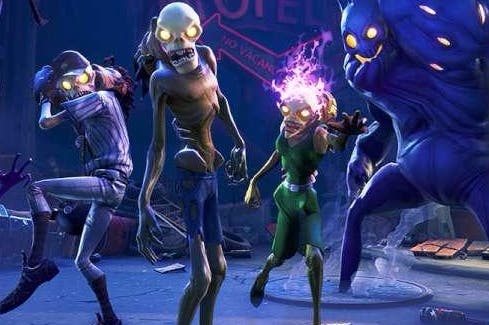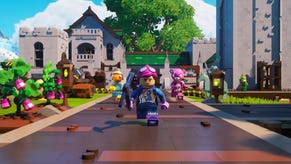So far, Fortnite feels less than Epic
Grinding gears.
There's only so much excitement you can build into the act of grinding materials or opening loot crates, but Fortnite tries its damnedest. Thwack an abandoned car with your pickaxe and it'll quiver like a punch bag, tempting you to take another swing in much the same way that cats can't help reaching for a dangling cable. Smack it repeatedly and you'll hear musical notes, rising irresistibly to a crescendo; freed resources also hover before you flirtatiously before squirting away into your inventory. There's an unlockable subsystem which coats stricken objects with blue bullseyes - take aim at these, and you'll be rewarded with a bassier crunch and bonus damage, an incentive to be precise which makes farming the game's procedural landscapes a tiny bit less monotonous.
Loot crates, meanwhile, take the shape of robot llama pinatas, bashed to pieces on the menu screen (there are also treasure chests to find on mission, for the traditionalists, their presence given away by strains of adult contemporary). Here, too, Epic has gone to great lengths to inject some sparkle. Every time you hit a llama you're given a different blunt implement, and each llama greets its death with a Whedonish quip like "that's all she wrote!" If you're thinking "that sounds perfectly obnoxious" you are, of course, correct - this kind of lumbering goofball humour is, alas, endemic to Fortnite. But the underlying goal is a respectable one: to make the process of accrual apparently intrinsic to any service game propped up by microtransactions feel less like grubby avarice, more like magic. It's just a shame that such measures were necessary at all. Much as Chris Tapsell found in June, Fortnite is its own worst enemy, a tug of war between core concept and business model that seems likely to end in stalemate.
Consider the sorely undermined charm of its premise. A long-in-development marriage of sandbox construction elements and third-person gunplay, Fortnite harkens back to the joy of building forts as a kid with your friends - throwing together warrens of sofa cushions, pillows and blankets, then defending them against imaginary villains (or in my case, non-imaginary sisters). It also harkens back to Epic's Gears of War 2, where skilled Horde Mode players would sometimes group together behind pilfered Boomshields to create a mobile perimeter in a world of fixed cover, one of the key inspirations for deployable fortifications in Gears of War 3.
The basic thrill of both these formative experiences lies with using objects in ways those objects weren't designed to be used. So it's a bit of a kick in the pants when, on launching into Fortnite's cheery post-apocalyptic world, you're saddled with a fixed construction suite and ordered to stuff it full of generic wood, brick and metal - an experience that, moreover, squats behind so many layers of interface that beginning a mission is like breaking into a fortress itself. Rather than puzzling out ways to make two chair legs and a sheet of corrugated iron look like Helm's Deep, you'll be sponging gobbets of resource out of superficially varied bucolic landscapes, then struggling to remember which pre-existing item recipes they correspond to. It is to the spirit of childish make-believe what Fanta is to fruit.
The game's construction suite is, in fairness, quite elegantly designed, streamlined enough that you could credibly hammer out a series of barricades while picking off the game's undead opponents. Toggled with a single button press, the real-time editor lets you slap down and lock together floors, walls, ramps and ceilings in seconds, and you can tinker with each prop before and after crafting it, deleting squares on a blueprint grid to sculpt out arches, spiral stairways, doors, balconies and that most Epic of entities, a chest-high cover spot.
Crafting traps, which range from spike strips to Tesla coils, is fiddlier. You'll need rarer special resources like duct tape or machine components (which are more abundant in some biomes than others) and getting at them involves diving into the multi-tabbed inventory. Still, having to search for these rarer resources rather than just wailing mindlessly on any free-standing objects adds a bit of much-needed spice to exploration, and Fortnite's construction options predictably come to life when you get a few friends involved. The game's missions mostly hinge on finding some artefact in the world that needs protection, building a base around it, then powering it up to start an attack - a rhythm that leaves plenty of time for squabbles over things like tactical bounce pad placement, or how best to funnel the assault past as many of your dart launchers as possible. You'll circle and bicker, batting down each other's creations imperiously. You'll send out parties into the wilds to forage for missing ingredients, or activate the gizmos that confer short-lived team buffs. You'll get distracted by things like mineshafts or NPCs you can rescue for a small bonus. Then, having finally erected something worth fighting for, you'll get into position and trigger the onslaught. And that's when you'll run into Fortnite's other big disappointments, the zombies themselves.

Gears of War's Horde Mode called upon the full flower of the Locust legions, from giants swinging morning stars through electric centipedes to barking tumours on legs. It might have been a "Swarm" but the individual units were never interchangeable. Fortnite, by contrast, has a bunch of off-colour tower defence units wearing raggedy Halloween costumes. There are different zombie types to contend with - some throw bones, some cough up fire from behind hills, some waddle forward soaking up shots to claw at your walls - but they're all warmed-over concepts, and the threat they pose is chiefly weight of numbers. There's a certain satisfaction to feeding them through the sadistic mechanisms of your base - using giant pistons to launch them into electricity traps, for example - but even then it doesn't feel like a fight, more a question of herding variables.
It's all rather sad when you consider the absolute embarrassment of ways to tailor your approach in combat, from weapons of different rarities you can upgrade at exhausting length, through unlockable character class abilities and buffs, to NPCs you can summon from deployable pads to assist you. These are riches that went mostly unregarded during my couple of days with the game - whether you're a melee-oriented ninja or a defensively minded Constructor, armed with a shotgun, a katana or a sniper rifle, you'll cut down zombies like you're mowing the lawn. Indeed, their chief contribution to the game is simply to increase the amount of time you spend tabbing from one headache-inducing inventory screen to the next on the nightmarishly busy customisation menu.
I'm conscious as I write all this that I am very much not Fortnite's target player. I no longer have time in my life for games that consist largely of pummelling the XP out of screen furniture so I can manufacture a bigger stick. At the same time, though, I'm not entirely sure who is Fortnite's target player. The whole "kids building forts" theme speaks to a fundamental ambiguity: it's not clear whether this is a game for actual children, who will probably take one look at the game's monstrous blimp of a hub interface and run for the hills (or Minecraft), or a game for nostalgic adults, who may find the combat too lacking in structure or the kinesis of Epic's previous action titles. So far, Fortnite feels like a tediously drawn-out waste of genuinely intriguing ideas. Perhaps that disappointment will fade after a few dozen hours, once I've enlisted a few dedicated friends and gotten used to all the inventories, but - llamas or no llamas - I'm not sure that's a commitment I'm happy to make.










.png?width=291&height=164&fit=crop&quality=80&format=jpg&auto=webp)







